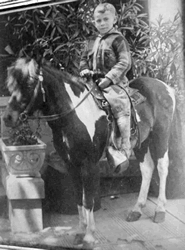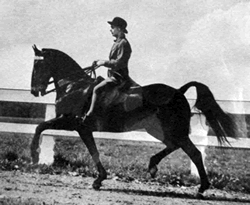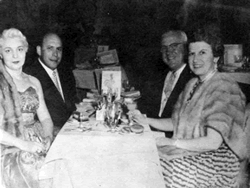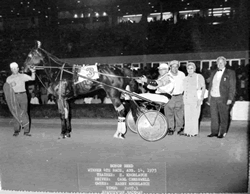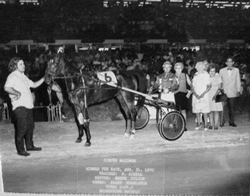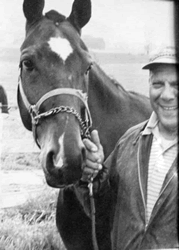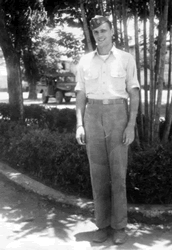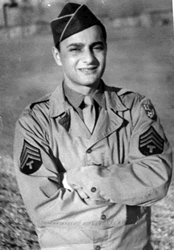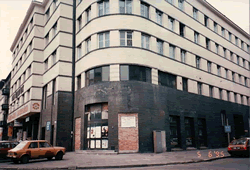Knoblauch Family
Click on Photos to Enlarge
#nblch-1
#nblch-2:
#nblch-3 - #nblch-8
Joel Knoblauch wrote;
Horse photos from my cousin Harry Knoblauch
I want to let you in on these rarely distributed photos of Harry and Edith.
Harry von Knoblauch, brother of Karl von Knoblauch (barongarlic) also races trotters.
It would be great if someone has the mechanism to convey (easily) the photos to Roman.
#nblch-3
#nblch-4
#nblch-5
#nblch-6
#nblch-7
#nblch-8
#nblch-9:
My father was Navy-man and eventually Lieutenant JG, Sidney Knoblauch.
~Joel
#nblch-10:
Lieutenant JG, Sidney Knoblauch.
~Joel
#nblch-11:
My uncle Murry (Maurice) Knoblauch.
~Joel
#nblch-12
#nblch-13
#nblch-14
#nblch-15
#nblch-16
Oskar Knoblauch
Oskar Knoblauch was born November 27, 1925, in Leipzig Germany where he lived with his parents, sister Ilse and brother Siegmund. He attended kindergarten through 3rd grade in Leipzig until the law passed by the Nazi regime forbidding Jewish children to attend schools or any other institutions of learning. In 1936 the family was forced to leave Germany because his parents were Polish citizens. They settled in Krakow, Poland where Oskar continued his education until the outbreak of World War ll, September 1, 1939. Soon after the German occupation of Poland new laws and restrictions were imposed against the Jewish population, including the wearing the Star of David on the right forearm.
In March 1941 a 9-foot walled ghetto was established. The Knoblauch family was assigned to one room in an apartment house on Ulica Benedikta. Forced labor and deportations to concentration camps started as early as mid-1941 and continued with deadly intensity, until the ghetto’s liquidation March 13, 1943. At that time Mrs. Knoblauch was sent to a slave labor camp, Plaszow while Oskar and the others in the family, along with 116 Jews from the ghetto were assigned to work at Pomorska. Oskar’s workstation was the boiler room in the basement that provided hot water and heat for this gigantic complex. This place was the headquarters for the: Geheime Stadts Polizei (Gestapo), SD (Security Department) the SS and SP (Security Police).
While working as forced laborers at Pomorska Street, Mr. Knoblauch was murdered by a Nazi. Oskar along with Ilse and Siegmund escaped on January 17, 1945 and were liberated the following day by advancing Soviet soldiers. The rest of their fellow workers were deported the eve of January 17th to a Konzentrationslager or concentration camp in the German interior. Very few survived.
In summer of 1945 after the war, Oskar and his siblings were very fortunate to reunite with their mother and cousin. Ilse and her husband, whom she married after the war, left Krakow to join a kibbutz in the Negev Desert. Siegmund went to the British occupied sector, while Oskar along with his mother and cousin ended up in displaced person (DP) Camp Feldafing near Munich, which was at the time in the American occupied sector.
The options of settling down anywhere in post-war Europe, were very slim for surviving Jews. The resentment toward Jews was common practice as it had been before World War ll. After locating an uncle in Canada, they were sponsored by a generous elder Toronto couple. On June 11, 1949, after a 7-day ocean voyage they arrived in Halifax, Canada.
As the situation in Germany deteriorated it became necessary for my family to move to Krakow, Poland, in 1936. We had hoped this move would return us to a normal life, but it was not to be. The outbreak of World War II, on September 1,1939, and the invasion of Poland would mark the beginning of a dark and troubling time for my family and millions of other Jews. The next six years would become one of the most horrific eras of human history, with the death of over six million Jews and countless other innocent people! After the war, in 1945, I ended up in a DP (displaced person's) camp, in Feldafing, Germany. With the generosity of a Canadian family, I was able to get sponsorship to enter Canada. After a seven day ocean voyage, on June 11, 1949, I arrived in Halifax, Canada.
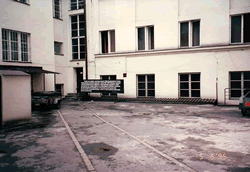
Courtyard leading to the basement holding cells at Pomorska

Oskar's father and grandmother before the war in Poland,1937

Knoublach family photo in Leipzig forest in 1932. Oskar was 7 years old
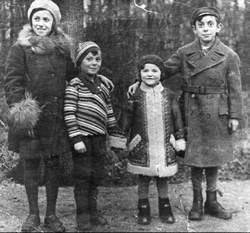
Oskar's siblings and cousin in 1930
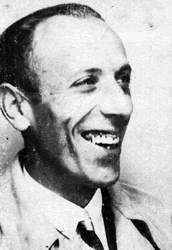
Oskar's father. He was killed during the war in early 1944
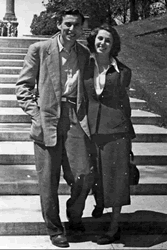
Oskar and his wife, Lila, in 1953 at Niagra Falls. They met in 1951 for the first time at Niagra Falls.
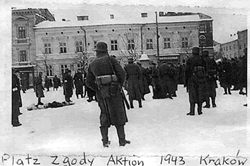
Platz Zgody, Krakow ghetto Aktion, 1943
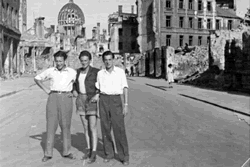
Oskar with friends in Munich, Germany after the war, 1946
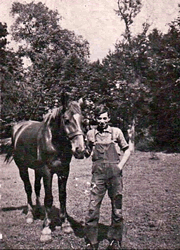
Oskar on the farm during forced labor in 1943
I was soon to meet the love of my life, Lila, and be married in Toronto in 1951. After starting our family in Canada, we decided to move to the United States of America in 1953. There, we raised three children and began living a wonderful life in this truly great country. After living in many beautiful states of the U.S., I retired in Phoenix, Arizona, in 1995. With much encouragement from my family, I began writing a journal of my Holocaust experience. Finally in 2007, my journal evolved into a book, "A Boy's Story - A Man's Memory Surviving the Holocaust 1933-1945", which was published in 2010. I am honored to be asked to come into classrooms and auditoriums to speak to children and adults of all ages about my book and details of the Holocaust.
By David M. BrownSpecial for The Republic | azcentral.comFri Nov 23, 2012 8:55 AM
Oskar Knoblauch, 87, once lived the terrors of hatred. Today, in classrooms, auditoriums, libraries and elsewhere in the community, the Mesa man teaches the importance of courage and perseverance, tolerance and forgiveness, hope and respect by sharing his experiences with the Holocaust and life in a Nazi concentration camp.
He was born Nov. 27, 1925, in Leipzig, Germany, and recalls to his audiences his fulfilling and quiet childhood with two caring parents, sister Ilse and brother Siegmund.
“My early childhood ... was a happy and carefree time, a perfect time,” he said. “We were members of a sports club, played on soccer teams and had many good friends in our Christian neighborhood. All those friendly people never cared what religion we were worshiping.”
All that shattered in 1933, when Adolf Hitler and the Nazis assumed control of Germany.
Although the city’s mayor from 1930 to 1937 was the anti-Nazi conservative and monarchist Carl Friedrich Goerdeler, Knoblauch’s parents foresaw the worst and moved the family to Krakow, Poland, in 1936.
Knoblauch and the family acclimated, learning the Polish language; the children continued their education. For the following three years, life again showed signs of peace. “We had hoped this move would return us to a normal life, but it was not to be,” Knoblauch recalled.
Soon after the German occupation of Poland in 1939, new laws and restrictions were imposed against the Jewish population, including wearing the star of David on the right forearm. In March 1941, a 9-foot walled Jewish ghetto was erected.
His family was assigned to one room in an apartment house on Ulica Benedikta. Forced labor, meager food rations and deportations of ghetto dwellers to concentration camps began as early as mid-1941. This continued until the ghetto’s liquidation in March 1943, he says.
The family was separated from his mother, who was sent to the slave labor camp Plaszow. The remainder, with 116 other Jews, were assigned to work at the sub-camp, Pomorska, headquarters for the Geheime Staatspolizei\\ (Gestapo), SD (Security Department), the SS and SP, the Security Police.
While working as forced laborers, Knoblauch’s father was murdered in 1944 by one of the officers. He, his sister and brother escaped from Pomorska on Jan.17, 1945, a day before they were liberated by the Soviet Army.
That summer, they were reunited with their mother, but post-war Europe was hardly better for surviving Jews, as resentment intensified in the devastated countries. They immigrated to Canada on June 11, 1949. On arrival in Toronto, Knoblauch, 24, went to night school to learn English and joined the workforce.
Two years later, he married Lila, a U.S. citizen; they had a son and daughter, Paul and Tracy.
The family moved to the United States in February 1953. Three years later, he became a naturalized citizen.
They settled in Phoenix in July 1970, and in 1995, at age 70, he retired from operating a day-care center for children. In the interim, both his wife and daughter died from cancer.
He visited Germany and Poland in 1995 and 1998 and began leafing through his journal from before and during the war. He decided to transform it into a book: “A Boy’s Story — A Man’s Memory Surviving The Holocaust 1933-1945,” published in 2010
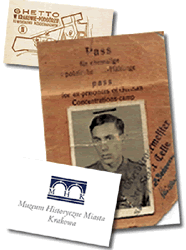
Since then, he has spoken about his experiences. “It is my duty to share the frightening events and to reflect on the lessons learned from the Holocaust,” he said.
“Life is a gift ... and a learning experience. Each of us will encounter challenges that may (be) negative or positive in nature impacting our lives,” he said. “I have learned that negative attitudes or thinking and hate are counterproductive; they cloud your thinking and prevent rational decisions.”
From Yad Vashem;
Majer Knoblauch was born in 1860. He was a butcher and married Rózia nee Lehrfeld. Prior to WWII he lived in Krakow, Poland. During the war he was in Krakow, Poland.This information is based on a List of persecuted persons found in Card file of Jews in Krakow with German identity card ("Kennkarte") nos. 4705-5000, with personal details and photographs, 02/1941
Smuel David Knoblauch was born in Krakow, Poland in 1885 to Yosef and Braindel Nacha. He was a merchant and married Beila nee Luftig and had 5 children. Only the daughter who came to Israel before the war survived. his children; Feiga Jungerwirth nee Knoblaukh age 35 (perished with husband Yechezkel and 2 children Ruth age 9 and Moshe age 2), Sara Gutter age 32 ( Perished with husband Yechezkel and daughter Feiga age 3), Baruch age 30 and Necha age 22 all perished.
Prior to WWII Shmuel David lived in Krakow, Poland. During the war he was in Chrzanow, Poland.
Samiel was murdered in the Shoah.
This information is based on a Page of Testimony (displayed on left) submitted by his daughter Chana Shaani of Ramat Yochanan doar Kfar Macabee. She gave more reports in 1988 and she then lived in Carmiel ,Prachim Street 21/24
Beila Knoblauch nee Luftig was born in Chrszanow, Poland in 1887 to Shmuel and Braindel nee Timberg. She was married. Prior to WWII she lived in Poland. During the war she was in Chrszanow, Poland.
Beila was murdered in the Shoah.
This information is based on a Page of Testimony (displayed on left) submitted by her daughter Chana Shaani .
-- Marcus Cnoblauch was born in Wadowice, Poland in 1900. He was a merchant and married Yokhevet. Prior to WWII he lived in Katowice, Poland.
Marcus was murdered in the Shoah.
This information is based on a Page of Testimony (displayed on left) submitted by his relative Yokhevet Cnoblauch.
Yaakov Cnoblauch was born in Wadowice, Poland. He was married Frida. Prior to WWII he lived in Maehrisch Ostrau, Czechoslovakia. During the war he was in Maehrisch Ostrau, Czechoslovakia.
Yaakov was murdered in the Shoah.
This information is based on a Page of Testimony by his relative Yokhevet Cnoblauch.
Josef Knoblauch was born in Krakow, Poland in 1919 to Favel and Freidel. He was a hatter and single. Prior to WWII he lived in Krakow, Poland. During the war he was in Krakow, Ghetto.
Josef was murdered in the Shoah.
This information is based on a Page of Testimony (displayed on left) submitted by his brother Lila Knoblauch .
Faiwel Knoblauch was born in Pilzno, Poland in 1891. He was a merchant and married. Prior to WWII he lived in Krakow, Poland. During the war he was in Pilzno, Poland.
Faiwel was murdered in the Shoah.
This information is based on a Page of Testimony (displayed on left) submitted by his son Lila Knoblauch , a Shoah survivor.
Abraham Knoblauch was born in 1906. He was a lackierer and married Gusta nee Finkelstein. Prior to WWII he lived in Krakow, Poland. During the war he was in Krakow, Poland.
This information is based on a List of persecuted persons found in Card file of Jews in Krakow with German identity card ("Kennkarte") nos. 2541-2800, with personal details and photographs
